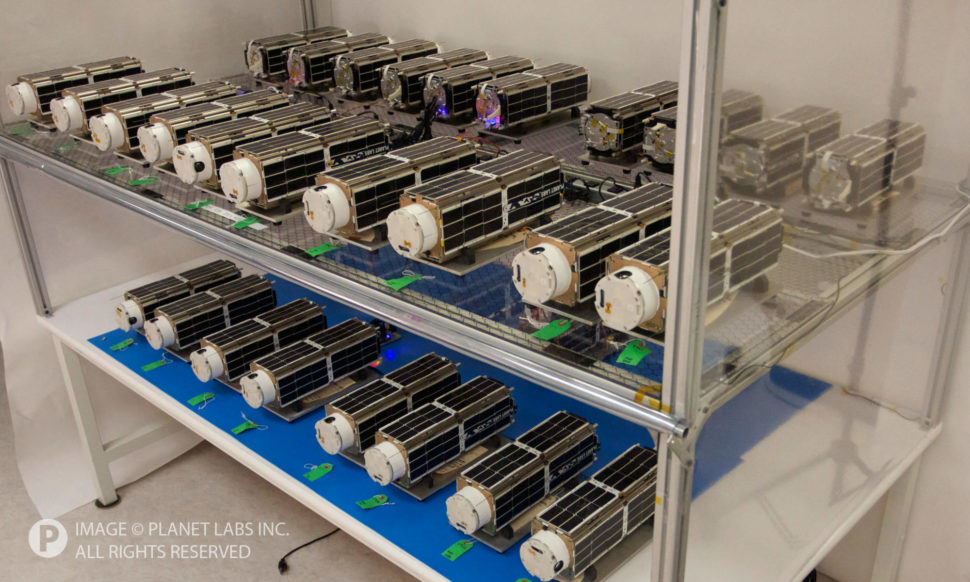Planet Labs, a private startup, launched a swarm of 88 CubeSats (backpack-sized private satellites) aboard a rocket that took off from India. With a total of 149 satellites in orbit, Planet Labs became the owner of the largest private satellite fleet.
From now on, NASA might want to collaborate with startups like Planet Labs. By allowing the private sector to manage close-to-home space operations like managing private satellites, NASA can focus more on deep space exploration.

SpaceX will soon be sending two lucky tourists around the moon. Where NASA once focused, the private sector now thrives.
Planet Labs: It’s the Size That Counts
Planet Labs deployed a constellation of 149 nano-satellites, and despite the Antares rocket explosion that was carrying 26 of its private satellites, Planet Labs doesn’t intend to slow down.
Based in San Francisco, Planet Labs is a startup that was created in 2010 by a group of ex-NASA scientists with a mission to photograph the entire planet daily. To do so, the company based its strategy on the CubeSat technology developed by Stanford University.
#PlanetLabs operates more private satellites than any other organization.Click To TweetThese satellites weigh only 4.7 kg, occupying a volume of 10x10x30 cm and make a complete orbit in 90 min. Despite their size, which is their first asset, CubeSats can connect and interact to form a network and observe the Earth with a resolution of less than one meter per pixel.
The costs of manufacturing, launching and operating CubeSats are negligible compared to traditional satellites. Furthermore, Planet Labs uses available and affordable consumer electronics and open source software.
While an organization like NASA has to manage larger, more cumbersome satellites, Planet Labs’ high number of small, inexpensive private satellites keeps them agile. The tiny, private satellites, called “Doves” take dozens of photos of Earth at the same time. They synchronize and compile their photos readily, and do it all again starting with the next orbital rotation. PlanetLabs thereby realized its dream of an automatic imaging platform of the Earth that is both more efficient and easier to operate.
The Good, the bad, and the Ugly
Who does Planet Labs service? Currently, Planet Labs deals with a wide range of clients. From the agricultural sector to consumer mapping to disaster relief, Planet Labs laser focus on continually mapping the Earth benefits many. This company could be an aid in monitoring the state of natural resources and oil reserves, as well as catching overfishing and illegal hunting of wildlife. They monitor deforestation around the world, and keep a keen eye on how humans affect the planet.
Any drawbacks? Unfortunately, the image resolution of the pictures these private satellites take is relatively low. It is serviceable, and allows the company to stay agile in data processing, but their images are not as useful as those of some competitors.
Maybe they could collaborate with Google? In an ideal world, Google’s experience in higher resolution, satellite image capture could be used to improve Planet Labs’ constant imaging of the Earth, and vice versa. In fact, Planet Labs recently acquired Google’s satellite imaging company, Terra Bella, which will allow Planet Labs’ satellites to raise their resolution above one meter per pixel.
If the resolution improves, won’t some pictures violate privacy? Yes, and that is a concern of Planet Labs. Experts predict that the startup will soon need to develop concrete processes for responding to complaints and requests to delete or blur certain images.
Big Demand for Updated Satellite Image
Previously a field for a few major players, satellite imaging has become a competitive, open market.
Many organizations can use the Planet Labs platform, or other similar solutions, to get the most up-to-date images, instead of Google Earth where some locations data haven’t been updated for years.



















Comments (0)
Most Recent